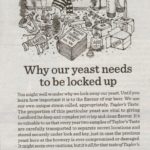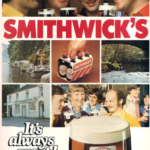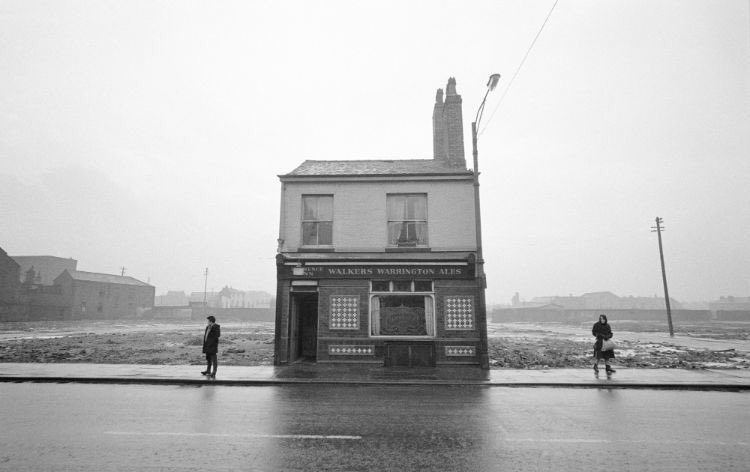 Finally. I am now convinced we may not get snow again… probably… the crops are a’risin’ and they are getting noticed and even harvested by strangers new to the neighbourhood. I even sharpened the manual mower and dug up the now dead fig tree’s root. In fact, I was reminded just last Saturday how much better beer was than having a fat guy at 59 heart attack when, laying on the lawn sweaty and staring at that damn fig root once cut from the planet which gave it life, I chose to have a beer rather than a heart attack. Good call. Meantime, I got on the Dall-E app thingie to see what all the cool kids are up to. Apparently the AI for the app likes its beer writers fat, white and male. I don’t dare show you the other three panels. Still… quite extraordinarily perceptive.
Finally. I am now convinced we may not get snow again… probably… the crops are a’risin’ and they are getting noticed and even harvested by strangers new to the neighbourhood. I even sharpened the manual mower and dug up the now dead fig tree’s root. In fact, I was reminded just last Saturday how much better beer was than having a fat guy at 59 heart attack when, laying on the lawn sweaty and staring at that damn fig root once cut from the planet which gave it life, I chose to have a beer rather than a heart attack. Good call. Meantime, I got on the Dall-E app thingie to see what all the cool kids are up to. Apparently the AI for the app likes its beer writers fat, white and male. I don’t dare show you the other three panels. Still… quite extraordinarily perceptive.
First up,  I love this image from the Mi’gmaw academic Robbie Richardson of Princeton – and his caption: “There was a two man band doing a mix of Pink Floyd and Louis Armstrong covers.” Fabulous. He was in a London working man’s pub and captured the spirit of the scene in this shot as well as a second photo. Note: not yet included in the listed, upgraded or relisted by the Department for Digital, Culture, Media and Sport on the advice of Historic England.
I love this image from the Mi’gmaw academic Robbie Richardson of Princeton – and his caption: “There was a two man band doing a mix of Pink Floyd and Louis Armstrong covers.” Fabulous. He was in a London working man’s pub and captured the spirit of the scene in this shot as well as a second photo. Note: not yet included in the listed, upgraded or relisted by the Department for Digital, Culture, Media and Sport on the advice of Historic England.
Speaking of pubs, there is pub ticking and there is speculative pub ticking that requires you to tick a pub just in case only to find out that the pub was not worth the tick! But in the tick that was not ticky there are also gems, like this beer right here, a Dulse Stout. I like the sound of that. But I grew up near the Bay of Fundy.
Evan demonstrated a deft use of social media on Wednesday with his multi-tweet, multi-media argument on the relationship between Czech culture and a state owned Czech brewery. Read it. It’s better than 87% of the paid beer writing this week. Here, let me start you off:
I keep seeing Czechs ask “Why shouldn’t we privatize Budvar?” aka “Why should the Czech Budweiser brewery remain under state ownership?” A few quick thoughts on the pros and cons.
A bit further out there, we have either apparently run out of gimmicks or have achieved master level gimmick:
A Scots brewery has joined forces with a company of professional musicians in a bid to discover whether playing piano to fermenting beer affects the taste… Sean Logan, a member of the company, is playing a wide selection of his music to two batches of new beer now in the fermentation tanks at Bellfield’s brew house. The two new beers – Resonancy IPA and Resonancy Pilsner- have been brewed specially for Pianodrome’s summer-long ‘Resonancy’ at their new, upcycled piano amphitheatre at the Old Royal High School.
And, never the gimmick, I missed this a month ago about the last Fred Fest coming and going:
This weekend marks the final Fred Fest, a rare beer charity event created to honor the birthday of legendary Portland beer journalist Fred Eckhardt. Later this summer venue host Hair of the Dog Brewing is closing, and this will be one of the last occasions to celebrate both owner Alan Sprints and Fred Eckhardt’s invaluable contributions to the industry in-person.
Boak and Bailey had somewhat positive experiences at three ‘Spoons and were pleasantly confused:
It was busy but peaceful with mostly older drinkers chatting in groups as diffuse sunlight warmed them through big windows. Ruddles was, again, surprisingly, delightful, this time at £1.49. Adnams’s Ghost Ship (£2.10) was good, too – a reminder of what a great beer this can be, full of citrus zest. The tables were spotless and polished and the in-house mag sat there looking harmless, with a cover feature about Curry Club rather than, say, DOES TRUTH MATTER?
But what about goes into what is in the glass? A study is being undertaken by my old alma mater, Dalhousie, in combination with two local breweries, 2 Crows and Propeller. They are looking to see if they can solve an old issue with how malt is made:
Historically, malting involved soaking barley in water, laying it out on the floor to germinate, and then drying it. This is a process called floor malting. Today, pneumatic malting is automated with large maltsters spreading the barley out on a perforated floor and blowing air through that floor to precisely control temperature and humidity before drying the malt. Two concerns about floor malted barley have been hindering the growth of craft malting: the potential for higher levels of a flavour-altering compound called Dimethyl Sulphide (DMS), and a condition called premature yeast flocculation…
Big picture, brewing industry economic challenges continue. Belgian brewers face bottle shortages:
Companies like the historic Huyghe brewery in Flanders, for example, are starting to run out of bottles. The lifeline, for now, is the accumulated stocks of bottles that were purchased from a supplier company in Russia. These days, supply has been interrupted and finding alternative suppliers with the capacity to respond in Europe is anything but easy due to the strong concentration that has occurred in the industry in recent years.
Similar stories out of the UK and Germany. Plus not enough C02. Plus drought. Plus the hot sauce is disappearing. (Glad I have backup.) In Hawaii and in Asia, the brewing basics are not as easy to get your hands on:
All food prices are going through the roof in Singapore. “It’s getting harder and harder for us to get any supplies at all,” Jesemann said. Hops and malt, delivered by ship from Germany, are also becoming hard to come by. The pandemic and the Russian war have made everything more complicated.
Now… there was an interesting set of three separate posts this week which added up to a bit of an interesting conundrum or at least signs of change. Worth unpacking. First, to set the scene, Jeff used all his fingers and toes and came to the correct conclusion that there are a lot of beer brands out there:
I was doing that same back-of-the-envelope math recently, and things have changed just a smidge. American breweries are within spitting distance of making a million individual beers. Maybe they already do. Three changes account for this. (1) The US has seen a more than fivefold increase in breweries since 2010, to around 9,500. (2) The number of beers each brewery makes has skyrocketed. Partly that’s a function of a changing market that rewards churn. But partly it’s a result of the fact that (3) almost all those breweries have taprooms, and a a lot have multiple taprooms. People are in turn drawn to those retail sites to sample new beers and buy four-packs they can’t get at the store.
I totally agree. We could also do a similar calculation of local bakery cookies, squares and other doodads. As things localize and multiply – as the dream of big national craft continues to fade – we have a splendidly mindboggling range of options… as long as you can be everywhere all the time. Which you can’t. Which leads me to Robin and Jordan writing in conversation as they do monthly for Good Food Revolution. This month they discuss the fragmentation of style over the same timeline that Jeff discusses his numerical ker’splosion:
J: It’s not just flavour, either. As part of the instruction at George Brown, I’m explaining to people about the Lovibond Company. They were stained glass manufacturers who came up with a standard colour spectrum for beer. Sort of pale straw down to deep brown, but in gentle gradation. One of the students asked, “So what happens when beer is suddenly pink?”
R: I do take your point. While styles have changed so much throughout the centuries, things do seem to be going pretty alarmingly fast in terms of flavour development, with everything but the kitchen sink being put into a beer. Sometimes the beer is even aged in a kitchen sink for that flavour.
It’s an interesting discussion – but, with respect, it does move a titch to the reactionary. In the sense that it depends on chestnuts like Garrett Oliver on wine (no, wines have a massive range of flavours) and dear old Michael Jackson (whose declaration of style as periodic table flopped way before the beer went pink.) But it serves as a great X axis to Jeff’s Y.* Facing this shock of the new… well, newish… we (rejecting the 1880s Michelson and Morley approach) should not worry about preserving a conceptual status quo. In the million brand universe the idea that beers can “rise up above all of the nonsense” like hit songs may not recognize that (i) the hits were rarely the most interesting songs** and (ii) there are far too many beers now for it to mean anything when a tiny foil Sunday School gold star gets awarded. It is simply no longer meaningful. That centre no longer holds.
Which leads us to Ben Johnson who has rejoined the land of the beer writer and posted his first post since last he posted in over a year and a half, reminding us all to disclaim the freebie:
It’s pretty basic marketing. For the cost of beer and shipping, you can put your product into the hands of people who are happy to share news and images of that product with your target audience. Beer writers and influencers get beer, they write about it and photograph it, and then share their work with their beer-loving followers; and the brewery, at least in theory, sells more of that beer.
This, too, is now a bit of a read guard action. Not because people don’t let folk know when a freebie is being discussed. We see disclaimers all over the place now – and that is great. Problem got solved. But the new problem is… it’s also sorta useless. And sorta 2018. Think about it. What beer drinker is now so weak of will that they are influenced? Wanted to be subjected to marketing? Second, many of the more interesting breweries just do not send freebie samples just like they don’t submit beers to award competitions. They know their base and have no need of the TikyToky marketplace of ideas. Third, too many freebie opinions boiled down to generic praise. Worse, fingerwaggery may ensue. Me, I can buy the beer.*** I can take the risk with a few bucks that I might not like something once in a while. Frankly, I am much more likely to be attracted by a skillful brewery that also displays a bit of good humour and jokes with itself. I am also much more interested, like Mr. Lemon, in what is a short walk away.
All of which adds up to something. And its something very different from even just pre-pandemic. The pre-pan. There is now just too much in beer to be aware of all that much about all the beer. It has been foretold, of course. Over seven years ago it was clear that it was impossible to be a “beer expert” but we are also well past even that. With the explosion of brands and styles and influencers (not to mention the seemingly hundreds of beer award competitions – now including a prize for iconic supermarkets? FFS. Really?? Have things gotten that tight for the award fee gatherers?) the confusion isn’t fading, it’s now a bazillion times worse. Or maybe better. Is all that variety actually all that bad ?
What can the poor beer writer do? No problem. Keep it specific. Look for the details. Experience what is actually there and now what you’re told should be there. And maybe write about it. That’s what I say. By this I mean if you are someone with the knowledge of what is good right there in your local area write about it… or write about what London Cooper was or… what is interesting about trademark law as it affects brewing or… or even what Ron has been eating… well, then you have half a chance to still be interesting and informative or even just funny. Write – even if its probably not all actually journalism. Writing is good. I’ve said it before but it’s worth repeating. Write. It’s hopeful thing. The hope that we acknowledge the rich niches which have replaced outdated umbrellas and overarches and authority figures. THIS JUST IN: no one need read Michael Jackson ever again except for archival purposes.
Perhaps connectedly, Stephanie Grant thought about something like it and wrote an interesting piece at her space “The Share” comparing craft beer now to the downsides of dating, including the fork in the road at phase 3 :
This is the part of the relationship where you start questioning things. Should I stay or should I go? It’s a hard question when beer has become part of my identity. What happens when it’s not? I left my job at the brewery. I started freelancing full-time. Initially, I dreamt of writing for breweries, but I started questioning that. Did I even want to work in the industry anymore? During this stage, my beer fridge went mostly untouched. It had been months since I posted about beer and even longer since I purchased a six pack. Meanwhile, my cocktail bar GREW.
Did she ditch the dud at phase 4? You will have to go read.
The rut is real – and, let’s be honest, maybe its because just as we have this unwieldy explosion of beer brands and alleged styles, we also have a limited range of beer writing themes.**** So much writing has not caught up with the scene from the consumer’s seat. Why listen to drinkers when you can talk at brewery owners? Yet… I think the last few years’ worth of new writing on social justice through the lens of beer is invigorating and, like the niche and the local, points to the way. Focused as it is on their personal experience, it is a step forward exactly because it’s written by people who actually do “think about press freedoms or the politics of their readers” and then think about their experience in beer overall. These writers have had to work to be heard. And beer doesn’t traditionally have much time for the bad news. Commissioning editors get the yips about bad news but these writers now sometimes write uncomfortable personal things. Discomforting interesting things – unlike what that DALL·E mini app would have us believe as illustrated above. It is also interesting that it is occurring just as established news services also shine a brighter light on the little ways of brewing. Again, I speak of hope. This is excellent. And it bodes well for a better future.
What’s it all add up to? In the million brand world, just don’t be a follower. Be the subject of the story of your own experience. We simply don’t have any use for the good old days when craft beer was the defined as the domain of the heroic great white male, whether brewer or writer. A past when perhaps, to channel Mr. Ahmir Thompson, we have been burdened by the achievers who kept down creatives. Someone should let the DALL·E mini app up there know we may be done with that. If we are lucky. It’s a needed change – because it was not all good and fun, whatever you were told.*****
There. Another long variation on a theme. But that’s what the beery news notes is for! Reading the writing. And for more, check out the updates from Boak and Bailey mostly every Saturday but not from Stan every Monday as he is on his summer holiday. Check out the weekly Beer Ladies Podcast, and at the weekly OCBG Podcast on Tuesday (Ed.: back again this week) and sometimes on a Friday posts at The Fizz as well. There is a monthly sort of round up at The Glass. (Ed.: that seems to be dead now.) There is more from DaftAboutCraft‘s podcast, too. And the Beervana podcast. And sign up for Katie’s irregular newsletter, The Gulp, too. And check out the Atlantic Canada Beer Blog‘s weekly roundup. Plus follow the venerable Full Pint podcast. And Fermentation Radio with Emma Inch. The AfroBeerChick podcast as well! And also look at Brewsround and Cabin Fever. And Ben has his own podcast, Beer and Badword (Ed.: …notice of revival of which has been given… still not on the radio dial…) And remember BeerEdge, too, and The Moon Under Water. There has also been the Beer O’clock Show but that’s now winding up after ten years.
*Another interesting X and Y graph would be where one axis represented the collapse of stylistic and branding certainty and the other axis represented the increase in card carrying Cicerones.
**Have you ever seen “Pina Colada Song” aka “Escape” lip sinc-ed vids? Big hit. In its fifth decade of existence. Shitty.
***This is my favorite line when a brewer offers me samples, that I am not one of that sort of writer. Brewery owner then laughs. Then I laugh. It’s a nice bonding time. Then I pay and go.
****They include: (i) social justice through the lens of beer, (ii) comforting praise for the rural brewery preferably founded by career changers… perhaps before they change back, (iii) beer writers interviewing beer writers and other circles of praise, (iv) possy spin over what arrived for free this week (yet… who could deny him this time?) and (v) affirmations of the abiding beer fibs through time like there is nothing to worry about the marketplace, temperance bad, puritans really bad, j-curve good ’cause beer is health food! (I often think of whether Gary Bredbenner so well remembered by Lew at the time now 13 years ago was affected by this… and Norm Miller as well.) Not to mention the crap that isn’t even beer. Fibs and lies, I say. Money in this case is the root of all evil, isn’t it… yet so is its absence.
*****Which is to say we are well past the day a decade ago when Melissa Cole could say that “brewing industry is not only booming and forward-thinking, it is also fabulously friendly” while James Watt was calling someone out by saying “…if we wanted advice from you, it would be about how to simultaneously patronise women and bastardize beer…” Quite the reversal! But it is a meaningful reversal of sorts as brewing is not and has not been a friendly place even if there are friendly faces to be found. And it’s good for us all to have grown up even if it means you leave behind those things of interest in youth.















